Imagine a skyscraper standing tall and majestic against the skyline, enduring the test of time and weathering the elements without losing its luster.
Much like this architectural marvel, stainless steel has become an essential component in modern construction, offering unparalleled strength and resilience.
But what makes stainless steel such a game-changer in the construction industry?
The answer lies in its remarkable properties and versatile applications, which continue to shape the way we build and design structures for the future.
Key Takeaways
- Stainless steel is highly resistant to corrosion, making it a durable choice for construction projects.
- It can withstand high and low temperatures, ensuring the structural integrity of buildings and bridges.
- Stainless steel offers flexibility and creativity in design, allowing for unique and innovative structures.
- The use of stainless steel in construction contributes to cost savings, aesthetic appeal, and the overall strength and stability of projects.
Stainless steel in construction

Stainless steel plays a crucial role in construction due to its high resistance to corrosion, ability to withstand extreme temperatures, and ease of fabrication, making it a versatile and durable material for various structural and architectural applications.
In the construction industry, there’s a growing trend towards sustainable construction materials, and stainless steel aligns with this trend due to its recyclability and long lifespan.
When considering stainless steel applications in construction, it’s essential to take into account design considerations such as the material’s strength, aesthetic appeal, and corrosion resistance. Additionally, maintenance and care are vital aspects to ensure the longevity and performance of stainless steel in construction projects.
As the construction industry continues to evolve, stainless steel remains a preferred choice for architects and engineers looking to innovate and create structures that aren’t only visually appealing but also durable, sustainable, and cost-effective.
When to work with stainless steel in construction
As you explore the integration of stainless steel in construction, understanding the decision-making process for utilizing this material becomes imperative for ensuring structural integrity and longevity in architectural projects. When considering when to work with stainless steel in construction, it is essential to weigh the benefits of stainless steel, common applications, and the importance and advantages of using this material.
| Benefits of Stainless Steel | Common Applications in Construction |
|---|---|
| High resistance to corrosion | Providing support and strength to structures |
| Ability to withstand high and low temperatures | Enhancing architectural designs |
| Easy fabrication and maintenance | Manufacturing lintels, wall starters, windposts, and masonry supports |
| Wide range of surface finishes available | Using stainless steel strip, plate, and wire for construction components |
| Cost-effective alternative to other materials | Utilizing stainless steel fixings such as wall ties, tying wire, screws, and nails |
Stainless steel is crucial in construction due to its cost savings, aesthetic appeal, resistance to corrosion, availability of various grades, and contribution to overall strength and stability. Examples of stainless steels used in structures include 430 stainless steel rods, which ensure structural integrity. By leveraging the advantages and examples of stainless steel in construction, you can create innovative and durable architectural marvels.
Austenitic stainless steels.
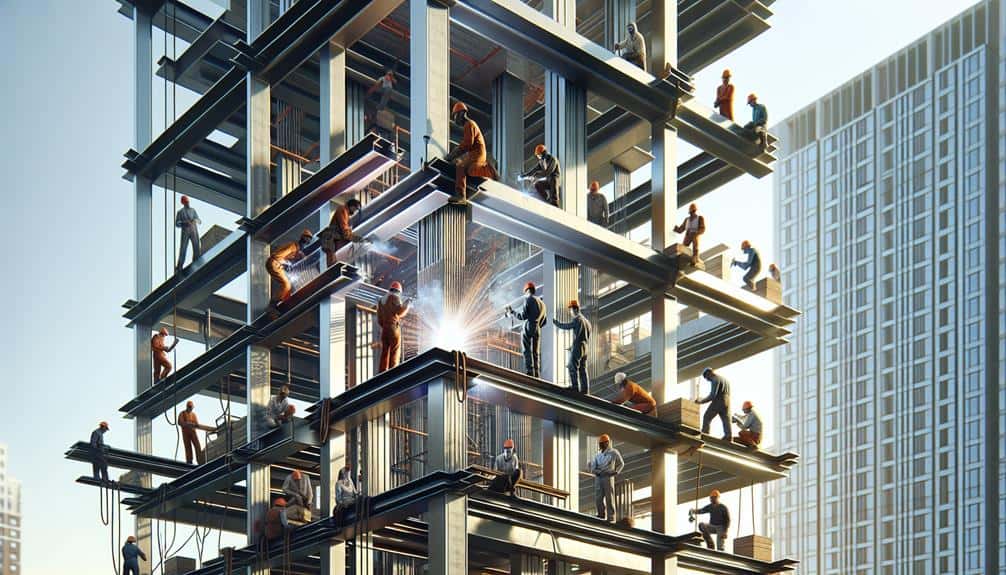
Austenitic stainless steels, such as S30400 and S30403, are crucial in construction due to their unique properties and applications. They offer high corrosion resistance and durability, making them suitable for various structural components.
The discussion of austenitic stainless steels will provide valuable insights into their specific characteristics and benefits for construction projects.
Austenitc steel in construction: S30400/S30403
When considering construction materials, the S30400/S30403, part of the austenitic stainless steel family, is a crucial choice for its exceptional properties and suitability for various construction applications. This grade offers unparalleled corrosion resistance benefits, making it ideal for structures exposed to harsh environments. Its fabrication considerations are advantageous, allowing for versatile shaping and forming processes, contributing to its widespread use. Additionally, the S30400/S30403 provides structural integrity advantages, ensuring the durability and longevity of construction projects. Moreover, its sustainability aspects make it an environmentally friendly option, aligning with modern construction practices.
- Versatile applications in austenitic steel
- Exceptional corrosion resistance benefits
- Fabrication considerations and structural integrity advantages
Duplex stainless steels
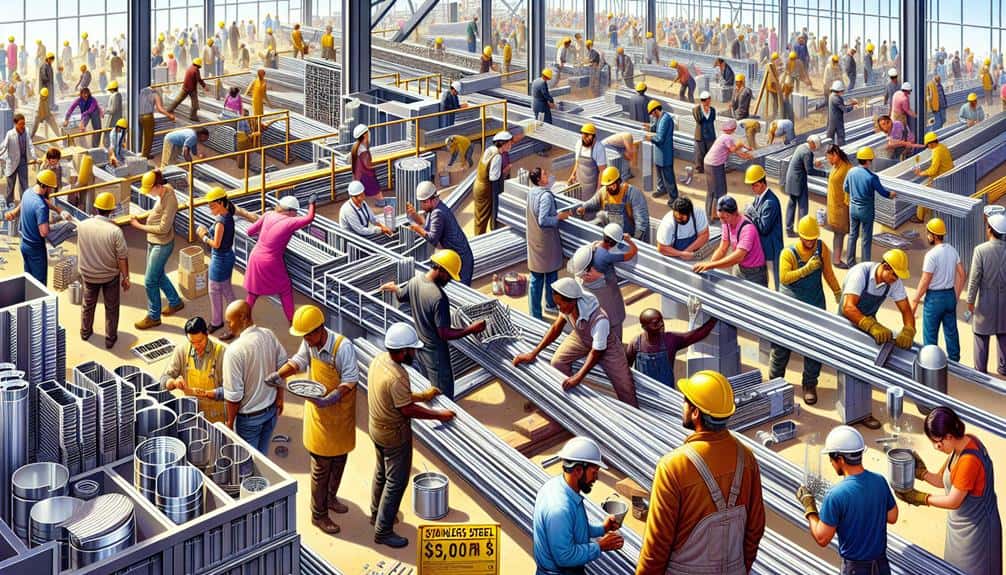
Duplex stainless steels, such as S32205, offer a unique combination of properties that make them suitable for various construction applications.
Their high strength and corrosion resistance make them ideal for structural components in challenging environments.
Additionally, duplex steels provide cost-effective solutions for projects requiring exceptional performance and durability.
Duplex steel in construction: S32205
S32205, a type of duplex stainless steel, offers exceptional strength and corrosion resistance, making it a valuable material for construction projects.
- Duplex steel applications:
- S32205 is used in structural components such as beams, columns, and bars.
- It’s employed in construction projects requiring high strength and corrosion resistance, such as bridges and offshore platforms.
- S32205 is utilized in architectural elements like facades, handrails, and support systems.
The benefits of S32205 include its high resistance to corrosion, exceptional strength, and durability. It provides a cost-effective solution for construction projects requiring robust materials. The corrosion resistance of duplex steel ensures the longevity of structures, making it an ideal choice for challenging environments.
More material and product specifications for construction
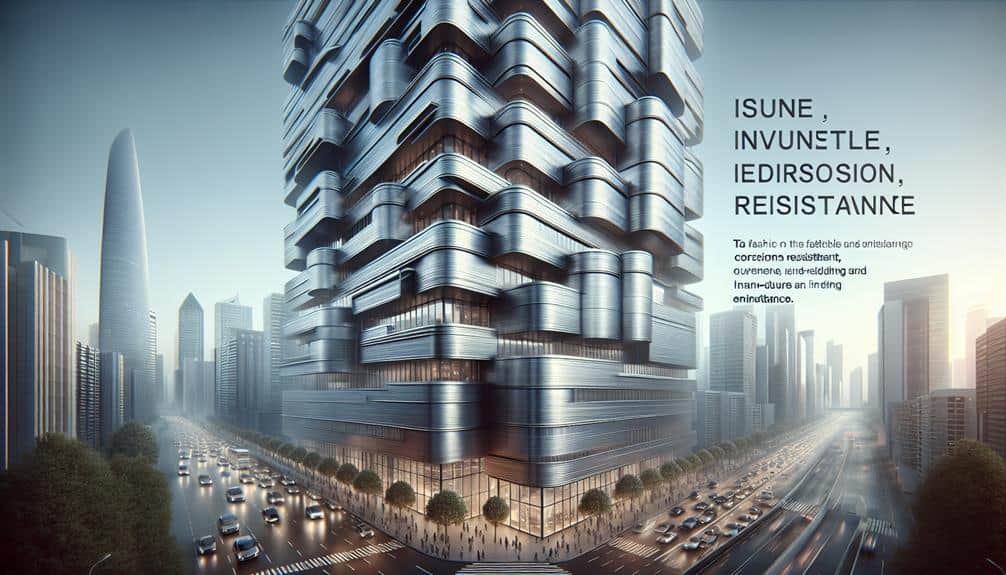
You can gain valuable insights into the material and product specifications for construction by exploring standards such as EN 10088 for Stainless Steels, ASTM A240/240M Standard Specification for Chromium and Chromium-Nickel Stainless, and ASTM A276 Standard Specification for Stainless Steel Bars and Shapes.
These specifications provide essential guidelines for selecting the appropriate stainless steel materials and products for your construction projects. Understanding these standards will help you ensure the quality, durability, and performance of stainless steel components in various construction applications.
EN 10088: Stainless Steels
When considering material and product specifications for construction, EN 10088 provides comprehensive standards for the use of stainless steels in various structural applications. This includes design standards for ensuring the structural integrity of buildings and bridges.
The corrosion resistance of stainless steel is a key advantage, ensuring the longevity and safety of structures. Additionally, EN 10088 outlines important fabrication considerations, enabling precise and efficient construction processes.
Examples of structures utilizing stainless steel in accordance with EN 10088 standards include architectural cladding for buildings, handrails for safety and aesthetics, and roofing materials for durability and corrosion resistance.
EN 10088 plays a crucial role in ensuring that stainless steel is utilized effectively in construction, providing guidelines for its optimal performance and long-term reliability.
ASTM A240/240M Standard Specification for Chromium and Chromium-Nickel Stainless
The ASTM A240/240M standard specification provides detailed guidelines and requirements for the use of chromium and chromium-nickel stainless steel in construction, ensuring precise material and product specifications for structural applications.
It encompasses a wide range of stainless steel grades suitable for various construction needs, offering high corrosion prevention properties essential for long-lasting structures.
The standard also addresses different surface finishes, allowing for aesthetic versatility and tailored solutions.
Additionally, it outlines fabrication techniques that optimize the material’s inherent strengths, promoting structural integrity and design flexibility.
ASTM A276 Standard Specification for Stainless Steel Bars and Shapes
The ASTM A276 Standard Specification provides detailed guidelines and requirements for the use of stainless steel bars and shapes in construction, ensuring precise material and product specifications for structural applications.
This standard plays a crucial role in the successful integration of stainless steel in architectural design and construction projects.
The standard covers a wide range of aspects, from austenitic steel applications to stainless steel fabrication techniques.
It also incorporates corrosion prevention methods, essential for ensuring the longevity and reliability of structures.
Additionally, the standard contributes to the sustainability of stainless steel in construction, emphasizing its eco-friendly and recyclable properties, further enhancing its appeal for innovative construction projects.
Properties of stainless steels used in structural applications
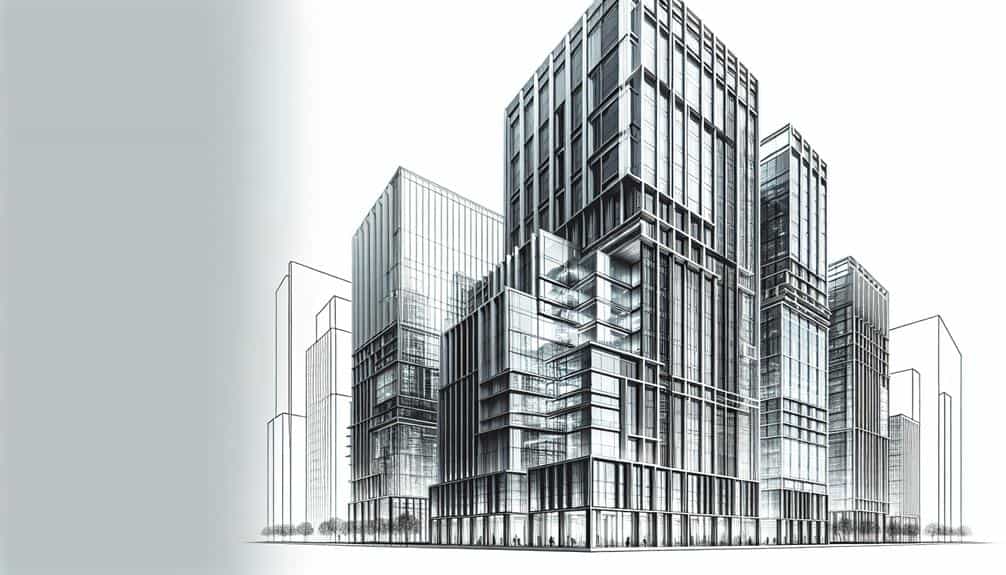
When considering stainless steels used in structural applications, it’s important to analyze their stress-strain behavior, properties at high and low temperatures, fatigue resistance, and sustainability.
Understanding the stress-strain behavior of stainless steel is crucial for designing and predicting the performance of structural components.
Additionally, evaluating the material’s properties at extreme temperatures is essential for ensuring structural integrity and safety.
Examining the fatigue resistance and sustainability of stainless steels provides insights into their long-term performance and environmental impact.
Stress-strain behaviour
Stainless steels exhibit a distinctive stress-strain behavior that’s essential to understanding their suitability for structural applications. Understanding the stress-strain relationship of stainless steel grades is crucial for design considerations and fabrication techniques.
Key factors such as the material’s yield strength, ultimate tensile strength, and elongation play a significant role in determining its performance in various applications in infrastructure. Additionally, the ability of stainless steel to resist deformation under tensile stress is essential for ensuring the structural integrity of buildings, bridges, and industrial structures.
Therefore, thorough knowledge of the stress-strain behavior of stainless steels is imperative for engineers and architects seeking innovative and reliable solutions in construction.
Properties at high temperatures
At high temperatures, the properties of stainless steels used in structural applications undergo significant changes, influencing their performance and structural integrity. Stainless steel exhibits remarkable thermal stability, ensuring structural integrity even in elevated temperatures. Its corrosion resistance remains robust, safeguarding the longevity and durability of constructions. The design flexibility of stainless steel allows for innovative solutions in high-temperature environments, ensuring safety and reliability. To provide a comprehensive understanding, here is a table highlighting the properties of stainless steel at high temperatures:
| Properties | Description | Importance |
|---|---|---|
| Corrosion resistance | Maintains integrity | Longevity and durability |
| Thermal stability | Resistance to heat | Structural integrity |
| Design flexibility | Creative applications | Innovative solutions |
These characteristics make stainless steel an indispensable choice for structures subjected to high temperatures.
Properties at low temperatures
Considering the influence of temperature on the properties of stainless steels used in structural applications, it’s imperative to understand their behavior at low temperatures to ensure sustained structural integrity and performance. Stainless steel properties at low temperatures are crucial for cold weather construction and construction material selection.
The steel strength at low temperatures is a decisive factor in determining the material’s suitability for low temperature applications. It’s essential to analyze the impact of low temperatures on the mechanical properties of stainless steel, such as toughness and ductility.
Additionally, understanding the potential for embrittlement and its implications on structural performance is vital for successful utilization in low temperature environments.
Fatigue
Understanding the fatigue behavior of stainless steels in structural applications is essential for ensuring the long-term reliability and performance of these materials.
Fatigue analysis plays a crucial role in assessing the fatigue life and fatigue strength of stainless steel components in construction.
Through rigorous fatigue testing, engineers can evaluate how stainless steel structures withstand cyclic loading and identify potential areas of concern such as fatigue crack growth.
By applying advanced techniques and methodologies, including finite element analysis and fracture mechanics, innovative approaches can be developed to enhance the fatigue resistance of stainless steel in construction.
This focus on fatigue properties facilitates the creation of robust and long-lasting structures, meeting the demands of modern construction projects and paving the way for continuous innovation in structural design.
Sustainability
Sustainability plays a pivotal role in determining the long-term viability of stainless steels utilized in structural applications. This encompasses their environmental impact, resource efficiency, and recyclability. When considering stainless steel in construction, it’s essential to focus on sustainable practices.
Stainless steel offers significant advantages in terms of sustainability. Firstly, its environmental impact is relatively low compared to other construction materials. Stainless steel production emits fewer greenhouse gases and pollutants, making it a more environmentally friendly choice. Secondly, stainless steel is energy-efficient. Its high strength-to-weight ratio allows for lighter structures, reducing the energy required for transportation and installation. Lastly, stainless steel is highly recyclable. It can be melted down and reused without losing its properties, supporting recycling initiatives and reducing waste.
The use of stainless steel in construction contributes to green building materials and promotes environmentally friendly construction practices. Its sustainable attributes align with the principles of sustainable development and the circular economy. By choosing stainless steel, construction projects can achieve structural integrity while also reducing their environmental footprint.
Advantages of Using Stainless Steel in Construction
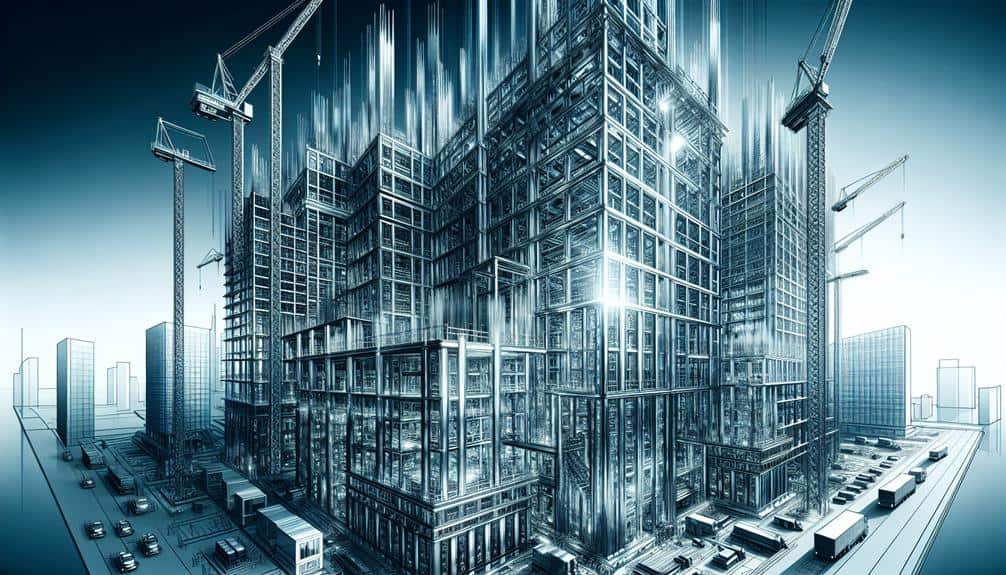
Stainless steel offers impressive strength and durability, making it an excellent choice for construction projects. Its high corrosion resistance ensures the safety and longevity of buildings and bridges.
Additionally, stainless steel’s flexibility allows architects to express their creativity with unique designs, contributing to the aesthetic appeal of structures.
Strength
The strength of stainless steel makes it an ideal material for construction projects, providing the necessary durability and support for various structures and components. Stainless steel boasts impressive mechanical properties, allowing buildings and bridges to withstand immense weight and pressure. Its high corrosion resistance ensures the longevity and safety of constructions, such as stainless steel rods used for structural integrity.
Architects can leverage its flexibility to create innovative and intricate designs, enhancing the aesthetic appeal of buildings. Stainless steel’s strength, durability, and corrosion resistance ensure a reliable and secure structure for occupants and users.
- Impressive mechanical properties
- High corrosion resistance
- Flexibility for innovative designs
Aesthetic Appeal
Enhancing the visual appeal of structures, stainless steel provides a sleek and attractive finish, elevating the aesthetic quality of construction projects. Its use allows for innovative designs, making it a preferred choice for architectural applications.
The sustainable materials offer structural integrity, ensuring longevity and low maintenance. Stainless steel’s ability to maintain its shiny and attractive appearance over time contributes to the overall aesthetic appeal of buildings. Its corrosion resistance ensures that the structures retain their visual appeal for an extended period.
This versatility and durability make stainless steel an ideal material for construction projects, meeting the demands of modern architecture.
High Durability
High durability is a key attribute of stainless steel in construction, ensuring the long-lasting structural integrity and low maintenance of buildings and architectural features.
Stainless steel’s durability and longevity make it an ideal choice for various architectural applications, providing robustness and resilience to structures. Its high resistance to corrosion reduces maintenance considerations, resulting in cost effectiveness over the lifespan of the construction.
Additionally, stainless steel’s environmental sustainability, due to its recyclability and long-term performance, adds to its appeal as a construction material.
These factors contribute to the overall strength and stability of buildings, making stainless steel an innovative and reliable option for construction projects.
Corrosion Resistance
In construction, stainless steel’s exceptional resistance to corrosion makes it a crucial material for ensuring the longevity and structural integrity of buildings and infrastructure. Stainless steel offers various benefits, including its high corrosion resistance, which is essential for preventing material weakening over time. Additionally, stainless steel requires minimal maintenance, reducing the need for costly corrosion prevention methods. The use of stainless steel cladding provides further advantages by enhancing the aesthetic appeal of structures while offering durable protection against environmental elements. Designing with stainless steel allows for flexibility and creativity, enabling innovative architectural solutions. Furthermore, the environmental impact of stainless steel is favorable, as it is fully recyclable and contributes to sustainable construction practices.
| Corrosion Resistance Benefits of Stainless Steel |
|---|
| High corrosion resistance |
| Minimal maintenance requirements |
| Aesthetic enhancement through cladding |
This table summarizes the key advantages of stainless steel in addressing corrosion concerns in construction.
Flexibility
Stainless steel’s flexibility enables architects and engineers to realize intricate and innovative construction designs with structural integrity and aesthetic appeal.
This flexibility in design offers numerous advantages in architectural applications, allowing for the creation of unique and complex structures that stand out.
Furthermore, it contributes to cost-effectiveness by providing durable and long-lasting solutions, promoting environmental sustainability through reduced material waste, and ensuring structural integrity for the safety and reliability of buildings and bridges.
Examples of Stainless steels used in structures

Utilize stainless steels in various structural applications to benefit from their impressive strength, durability, and corrosion resistance. Examples of stainless steels used in structures are highlighted in the table below, showcasing their diverse applications and benefits.
| Stainless Steel Grade | Application |
|---|---|
| 316L | Architectural Cladding |
| 304 | Handrails |
| 2205 | Drainage and Water Systems |
| 2304 | Wall Support Products |
Stainless steel grades such as 316L are commonly used in architectural cladding due to their high corrosion resistance, low maintenance requirements, and cost-effectiveness. Grade 304 stainless steel is preferred for handrails in structures, offering fire resistance, design flexibility, and ease of maintenance. For drainage and water systems, the application of 2205 stainless steel ensures longevity, cost-effectiveness, and excellent corrosion resistance. Additionally, 2304 stainless steel is utilized in wall support products, providing a balance of strength, corrosion resistance, and cost efficiency. These examples demonstrate the versatility and reliability of stainless steels in various structural applications, meeting the demands of modern construction projects.
Frequently Asked Questions
What Are the Environmental Benefits of Using Stainless Steel in Construction?
In construction, stainless steel offers durability and longevity, corrosion resistance, energy efficiency, material versatility, and positive environmental impact. Its unique properties make it an innovative and reliable choice for sustainable construction practices.
How Does the Cost of Using Stainless Steel in Construction Compare to Traditional Building Materials?
When comparing costs, stainless steel in construction offers long-term benefits with lower maintenance requirements. Its structural integrity and design possibilities make it a cost-effective and innovative choice for creating durable and visually appealing structures.
Can Stainless Steel Be Recycled at the End of a Building’s Life Cycle?
Yes, stainless steel can be recycled at the end of a building’s life cycle, contributing to the circular economy and environmental responsibility. Its high recycling potential and sustainability impact make it an excellent choice for construction.
Are There Any Special Considerations or Maintenance Required for Using Stainless Steel in Coastal or High-Salinity Environments?
In coastal or high-salinity environments, specialized maintenance is essential to uphold stainless steel’s corrosion resistance, material durability, and saltwater resistance. This ensures long-term structural integrity and design flexibility for innovative construction projects.
How Does the Use of Stainless Steel in Construction Contribute to Sustainable and Green Building Practices?
Using stainless steel in construction contributes to sustainable and green building practices through durability and longevity, design flexibility, corrosion resistance, energy efficiency, and material recyclability. It enhances structural integrity while minimizing environmental impact.
Conclusion
In conclusion, the use of stainless steel in construction offers unparalleled durability, cost savings, and aesthetic appeal.
From its high resistance to corrosion and extreme temperatures to its ability to provide strength and stability to structures, stainless steel is a versatile and essential material in the industry.
Whether it’s for cladding, roofing, or structural support, the applications of stainless steel in construction are vast and impactful, making it a top choice for architects, engineers, and construction professionals.


